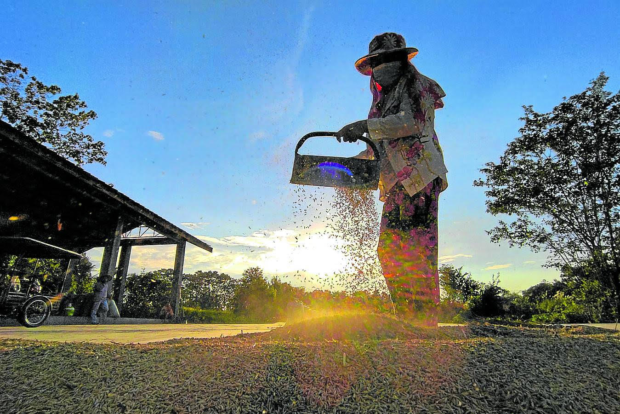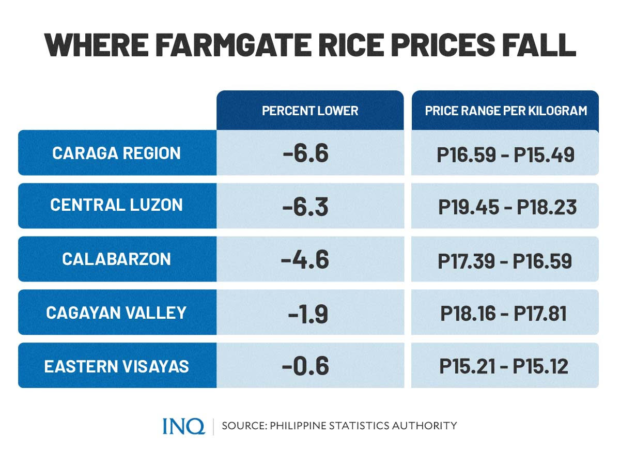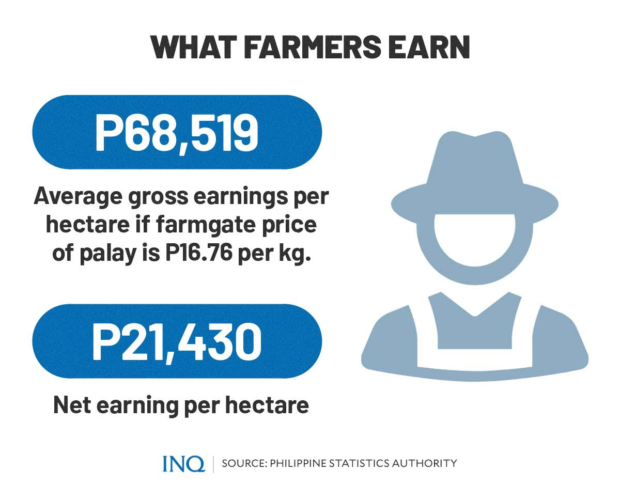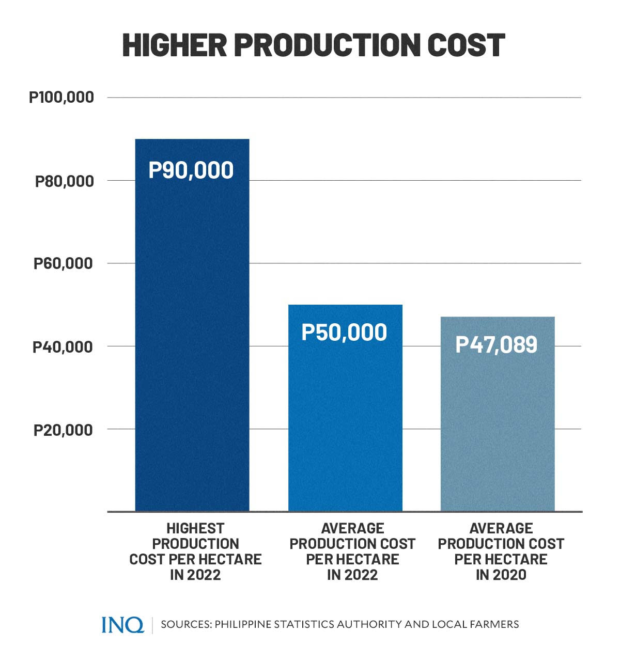Rise in farmgate prices won’t lift farmers as production costs overwhelm them

FILE PHOTO: During harvest season, rice farmers are usually up before daybreak to collect and store dried “palay” for hulling and milling. Farmers like this woman in Balungao, Pangasinan, now face a threat from imported agricultural products that will flow into the country under the new free trade pact among nations in the Asia-Pacific. RICHARD BALONGLONG
MANILA, Philippines—“Pitiful.”
Ricardo Villanueva said this as he told INQUIRER.net of the hardships of farmers like him: “We are really distressed. Some of us can’t even get back all our expenses.”
Last Feb. 25, Villanueva, a farmer in Victoria, Tarlac province, harvested 120 sacks of palay from his 1.4-hectare land.
Likewise, Arvin Caceres, a farmer in Libmanan, Camarines Sur province, told INQUIRER.net that he harvested 145 sacks of palay from his 2-hectare land on April 24.
Last April 13, the Philippine Statistics Authority (PSA) said the average farmgate palay (dry) price in February was P17.72 per kilogram.
Article continues after this advertisementThe P17.72 is 3.3 percent higher than the P17.15 per kilogram in January and 5.4 percent higher than the P16.81 per kilogram in February 2021.
Article continues after this advertisementThe PSA said out of 17 regions in the Philippines, six registered high yearly increases, relative to the average farmgate palay price in February last year.
• Zamboanga Peninsula
• 17.3 percent higher: P15.28 to P17.93 per kilogram
• Bicol Region
• 16.4 percent higher: P17.50 to P20.37 per kilogram
• Central Visayas
• 13.8 percent higher: P16.43 to P18.69 per kilogram
• Western Visayas
• 12.9 percent higher: P15.32 to P17.29 per kilogram
• Soccsksargen
• 6.4 percent higher: P15.26 to P16.24 per kilogram
• Northern Mindanao
• 4.7 percent higher: P17.20 to P18 per kilogram
The Bangsamoro Autonomous Region in Muslim Mindanao had the highest yearly increase—39.1 percent (P15.01 per kilogram in February 2021 to P20.88 per kilogram in February 2022).
The PSA said these regions registered the highest decline, relative to the average farmgate palay price in February 2021:
• Caraga Region
• Negative 6.6 percent lower: P16.59 to P15.49 per kilogram
• Central Luzon
• Negative 6.3 percent lower: P19.45 to P18.23 per kilogram
• Calabarzon
• Negative 4.6 percent lower: P17.39 to P16.59 per kilogram
• Cagayan Valley
• Negative 1.9 percent lower: P18.16 to P17.81 per kilogram
• Eastern Visayas
• Negative 0.6 percent lower: P15.21 to P15.12 per kilogram
READ: Imports’ continuing impact on PH farmers: Like dislocating the kneecaps
Reality
At P18.23 per kilogram, Villanueva, who harvested 120 sacks of palay, should have received P109,380, but he earned only P99,000.
This, as his palay harvest was bought for only P16.50 per kilogram, which was P1.73 lower than the average farmgate palay price in Central Luzon.
Caceres, who had 145 sacks, was likewise expected to receive P147,682, however, he had only P94,250 since his palay was bought for only P13 per kilogram
The P13 per kilogram was P7.37 lower than the average farmgate palay price in Bicol Region, which was P20.37 per kilogram in February.
Last year, the Federation of Free Farmers (FFF) even said that in some provinces, like Pangasinan, Tarlac, and Occidental Mindoro, palay was bought for only P12 to P15 per kilogram
FFF President Raul Montemayor told INQUIRER.net that the PSA’s average farmgate palay price in February was normal for the dry season (March to April).
He said the problem is greater in the wet season (October to December) since palay could be bought for only P16 per kilogram or lower.
Likewise, Montemayor stressed that the P17.72 per kilogram is still lower than the P19 “benchmark” of the National Food Authority.
Nothing left
Villanueva said the 120 sacks that he harvested in February was less than the 170 that he normally has.
This was one of the reasons that he was distressed, saying that he almost had nothing left for his family: “What we have now is only enough until the next harvest”.
READ: Farmers decry low unmilled rice farm-gate prices
This, as production cost rose while the farmgate palay price fell in some regions. “The cost of farm inputs is high, especially because we rely on diesel for the water pump for the whole cropping season,” he said.
Last year, the PSA said that in 2020, the average production cost was P47,089 per hectare—dry season (P46,650) and wet season (P47,196).
On a per kilogram basis., the average production cost of farmers was P11.52 per kilogram.—dry season (P11.53) and wet season (P11.53).
The average gross earning was P68,519 per hectare in 2020, when the farmgate palay price was P16.76 per kilogram—dry season (P70,921) and wet season (P66,086).
The PSA said the net return was P21,430 per hectare. Farmers had higher net returns in the dry season (P24,271) than in the wet season (P18,890).
Rising cost
Villanueva said that for this season, the production cost even went as high as P90,000 for his land since they rely on diesel for water pump because of lack of irrigation.
In February, the Department of Energy said the year-to-date hikes for fuel stood at a net of P10.20 per liter of diesel, P7.95 per liter of gasoline, and P9.10 per liter of kerosene.
In Caceres’ case, the production cost went as high as P50,000—fertilizers, insecticides, seeds, labor, and water.
Rogelio Cornejo, a farmer in Isabela province, told INQUIRER.net that urea (granular), which is a solid nitrogen fertilizer product, now costs P3,700, higher than P1,901 last year.
“This is too much,” farmer Emeliza de Torres said, stressing that farmgate palay price is still low as the cost of production is rising.
READ: Winners and losers from the rice tariffication law
The PSA said that in 2020, the net profit-cost ratio in palay production was 0.46—dry season (0.52) and wet season (0.40).
Last March, the Fertilizer and Pesticide Authority said the cost of fertilizers has seen an increase since late 2021 because of rising global demand.
Its director, Wilfredo Roldan, told TeleRadyo that the rise was because of the strong demand, especially from India, and China’s ban on exports of fertilizers.
‘Do something’
Montemayor said the slight increase in farmgate palay price has nothing to do with any conscious effort of the Department of Agriculture (DA) to make prices higher.
“In fact, imports in just the first three months of 2022 have already reached one million tons,” he said.
“The expected drop in palay output because of high fertilizer prices, increase in fuel costs and the Russia-Ukraine conflict, has caught the DA flatfooted on what to do,” he said.
RELATED STORY: PH set to end 2021 with more rice imports
For Montemayor, importers are taking advantage, anticipating that rice prices will go up both internationally and domestically, so they are bringing in more stocks than normal in anticipation of more profits in the coming months.
The FFF earlier said that the farmgate palay price could fall as a result of excess in rice importation.
READ: Rice glut seen with harvest season imports
“The government should be wary of imports, especially because when we are harvesting our crops, our harvest is only bought for a small amount since there are too many imports,” Villanueva said.
Last year, Malacañang assured farmers and rice producers that the government would not import rice during the harvest season so as not to affect local prices after the Duterte administration cut tariffs on imported rice.
READ: Gov’t won’t allow rice imports during harvest season – Palace
However, former Agriculture Secretary Leonardo Montemayor, said the Philippines is the only country he knows that permits the entry of rice imports even during the harvest season.
“It’s not just the typhoons that kill them, but also the law,” he said during the Experts Forum in Taguig City, referring to the Rice Tariffication Law.
RELATED STORY: P 21.75B in rice, pork import duties collected in ’21
TSB



